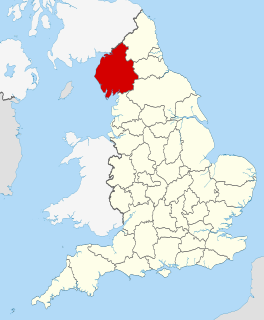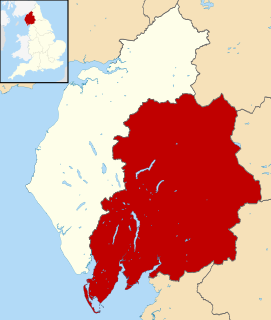
Cumbria is a ceremonial and non-metropolitan county in North West England, bordering Scotland. The county and Cumbria County Council, its local government, came into existence in 1974 after the passage of the Local Government Act 1972. Cumbria's county town is Carlisle, in the north of the county. The only other major urban area is Barrow-in-Furness on the south-western tip of the county.

Cartmel Priory church serves as the parish church of Cartmel, Cumbria, England.

Westmorland is a historic county in North West England. It formed an administrative county between 1889 and 1974, after which the whole county was administered by the new administrative and ceremonial county of Cumbria. The people of Westmorland are known as Westmerians. In April 2023, it is planned that local government in Cumbria will be reorganised into two unitary authorities, one of which is to be named Westmorland and Furness and would cover all of the historic county along with parts of historic Yorkshire, Lancashire and Cumberland.

Cumberland is a historic county in North West England that had an administrative function from the 12th century until 1974. It is bordered by the historic counties of Northumberland to the north-east, County Durham to the east, Westmorland to the south-east, Lancashire to the south, and the Scottish counties of Dumfriesshire and Roxburghshire to the north. It formed an administrative county from 1889 to 1974 and now forms part of Cumbria. In April 2023, local government in Cumbria will be reorganised into two unitary authorities; one of these is to be named Cumberland and would include most of the historic county, with the exception of Penrith and the surrounding area.

Grange-over-Sands is a town and civil parish located on the north side of Morecambe Bay in Cumbria, England, a few miles south of the Lake District National Park. In the 2001 census the parish had a population of 4,042, increasing at the 2011 census to 4,114. Historically part of Lancashire, the town was created as an urban district in 1894. Since the 1974 local government re-organisation, it has been of the South Lakeland district of Cumbria, though it remains part of the Duchy of Lancaster.

Furness is a peninsula and region of Cumbria in northwestern England. Together with the Cartmel Peninsula it forms North Lonsdale, historically an exclave of Lancashire.

Lancashire is a county of England, in the northwest of the country. The county did not exist in 1086, for the Domesday Book, and was apparently first created in 1182, making it one of the youngest of the traditional counties.

The Diocese of Carlisle was created in 1133 by Henry I out of part of the Diocese of Durham, although many people of Cumbric descent in the area looked to Glasgow for spiritual leadership. The first bishop was Æthelwold, who was the king's confessor and became prior of the Augustinian priory at Nostell in Yorkshire. Carlisle was thus the only cathedral in England to be run by Augustinians instead of Benedictines. This only lasted until the reign of Henry III however, when the Augustinians in Carlisle joined the rebels who temporarily handed the city over to Scotland and elected their own bishop. When the revolt was ended, the Augustinians were expelled.

Clifton is a small linear village and civil parish in Cumbria, England. Historically part of Westmorland, it lies 3 miles (4.8 km) south east of Penrith.

The Barony of Kendal is a subdivision of the English historic county of Westmorland. It is one of two ancient baronies that make up the county, the other being the Barony of Westmorland. In 1974, the entire county became part of the modern county of Cumbria and ceased to have an administrative function. At the same time, Kendal borough along with some other rural and urban districts in Westmorland was merged with the neighbouring parts of Lancashire, Furness and Cartmel, and also the Sedbergh Rural District of the West Riding of Yorkshire into the new South Lakeland district of the new county.

Marton-cum-Moxby is a civil parish in North Yorkshire, England. The population of the parish was less than 100 at the time of the 2011 Census, therefore its details were included with Farlington. It lies to the east of the villages of Stillington and Farlington, near Easingwold. The settlements are the hamlets of Marton-in-the-Forest and Moxby, both agricultural in character.

Cumbria County Cricket Club is one of twenty minor county clubs within the domestic cricket structure of England and Wales. Originally, it represented the historic counties of Cumberland and Westmorland. It now represents the ceremonial county of Cumbria, as defined by the Lieutenancies Act 1997. Cumbria was first created in 1974 as an administrative county by combining the traditional counties of Cumberland and Westmorland along with Furness and a small part of north-west Yorkshire.

Flookburgh is an ancient village on the Cartmel peninsula in Cumbria, England, until 1974 part of Lancashire. Being close to Morecambe Bay, cockle and shrimp fishing plays a big part in village life.

Farlam is a village and civil parish in the City of Carlisle District, in the English county of Cumbria. The village is about 2+1⁄4 miles (3.6 km) southeast of the small town of Brampton and 9+1⁄2 miles (15 km) east of the city of Carlisle. While the population has fluctuated over time, in the 2001 UK Census, the population stood at 590: 291 males and 299 females. The 2011 Census showed a population of 669: 331 males and 338 females.

Bolton Low Houses is a small village in the Allerdale borough of Cumbria, England. Historically part of Cumberland, it is located 3.1 miles (5.0 km) by road to the southwest of South End. There is a coal mining area to the east between Oughterside, Allhallows Colliery and Bolton No.2 Pit. In 1831, Samuel Lewis noted that there was a meeting house for dissenters in Bolton Low Houses. It contains a Methodist Chapel and a pub, the Oddfellows Arms.

Langrigg is a hamlet in Cumbria, England. It lies to the northeast of Aspatria and south of Abbeytown, just to the southwest of Bromfield. Historically, it formed part of the Langrigg and Mealrigg township, in the Parish of Bromfield, then an independent parish from 1894 until 1934.

The extent of the medieval district of Craven, in the north of England is a matter of debate. The name Craven is either pre-Celtic Britain, Britonnic or Romano-British in origin. However, its usage continued following the ascendancy of the Anglo-Saxons and the Normans – as was demonstrated by its many appearances in the Domesday Book of 1086. Places described as being In Craven in the Domesday Book fell later within the modern county of North Yorkshire, as well as neighbouring areas of West Yorkshire, Lancashire and Cumbria. Usage of Craven in the Domesday Book is, therefore, circumstantial evidence of an extinct, British or Anglo-Saxon kingdom or subnational entity.

Woodland is a dispersed hamlet within the civil parish of Kirkby Ireleth in the Furness region of Cumbria, England, and is located in the southern part of the Lake District National Park, west of Coniston Water, between Torver and Broughton-in-Furness.
The Cumbria Rugby Union is the governing body for the sport of rugby union in the county of Cumbria in England. The union is the constituent body of the Rugby Football Union (RFU) for Cumbria, and administers and organises rugby union clubs and competitions in the county. It also administers the Cumbria rugby representative teams.

Westmorland and Furness is a future unitary authority area in the ceremonial county of Cumbria in north-west England. The council will cover the areas currently served by the districts of Barrow-in-Furness, Eden and South Lakeland. It will include all of the area of the historic county of Westmorland as well as the Furness district of historic Lancashire. It will also incorporate a very small part of historic Yorkshire together with about quarter of the area of the historic county of Cumberland.


















